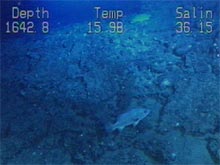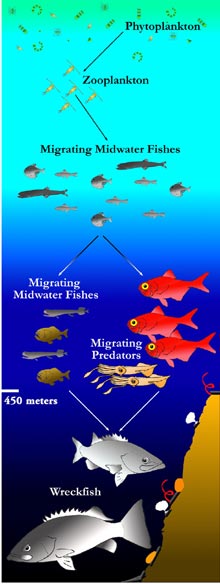
A submersible visit to the bottom of the Charleston Bump reveals 3-ft-long wreckfish, large barrelfish, and bizarre forms of corals and sponges bending into the current to scoop up the sparse plankton drifting in the Gulf Stream. Click image for larger view.
Life on the Bump
George Sedberry
Principal Investigator
The Charleston Bump is a hard, rocky, steep slope in deep, dark water. It is overlain by the swift-flowing and relatively nutrient-poor Gulf Stream current. Under such harsh conditions, one might expect to find a dearth of marine life. Yet a submersible visit to the bottom reveals 3-ft-long wreckfish, large barrelfish and bizarre forms of corals and sponges bending into the current to scoop up the sparse plankton drifting in the Gulf Stream.
The most characteristic feature of the Charleston Bump is that it is composed of hard rock outcrops. Sediments are swept away by the swift Gulf Stream currents, and soft clay, mud and fine sands that are more typical of the depths found on the Bump are not generally present. Animals that prefer or need hard bottom substrates dominate the bottom fauna of the Charleston Bump. Sponges, hydroids, corals and bryozoans grow on the hard substrate. Dominant fishes include representatives of families that are typical of hard bottom, such as congers, moras, scorpionfishes, and wreckfishes. Soft-bottom groups, such as flounders, are rare. Conger eels shelter in rock crevices and caves, and blackbelly rosefish (a deepwater scorpionfish) associate closely with deepwater corals. Wreckfish, barrelfish and alfonsins hover near the bottom and feed on abundant squid and midwater fishes.

Large bottom fish on the Charleston Bump are supported by vertically migrating food chains (from Weaver and Sedberry, 2001). Click image for larger view.
Life is Hard
What is life like on the Charleston Bump? At the 1,200 to 2,000-ft depths, it is nearly dark all the time. The currents are strong, but variable in speed and direction. In addition, the variations in current can result in bottom temperatures that can change as much as 10oC within hours. Food is scarce in this region because the hard bottom, swift currents, and variations in temperature provide little habitat for deposit-feeding worms and other benthic organisms that are an important part of shallow-water marine food chains. Any food produced in the sunlit surface layers around the Charleston Bump has quite a distance to travel and a gauntlet of predators to avoid before it is available to bottom-dwelling organisms.
A Food Conveyor Belt
Given these tough conditions, vertically migrating squids and fishes found in midwater (in the water column) are a major food source for the larger species of fish on the Charleston Bump. These vertical migrators rise to the surface at night to feed on the plankton produced there in the sunlit layers. During the day, these organisms seek deep, dark water to avoid predators. This strategy works well in the open ocean, but on the Charleston Bump, the daily vertical migration brings them in close contact with the shoaling bottom and the demersal fishes that live there. Vertically migrating squids, shrimps and fishes are the dominant prey of wreckfish. The Gulf Stream current brings a continuously renewed supply of vertical migrators to The Bump, to serve as prey for large wreckfish and other predators. This food “conveyor belt” helps support a small bottom fishery for wreckfish, barrelfish and alfonsins on the Charleston Bump.
























